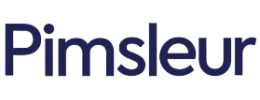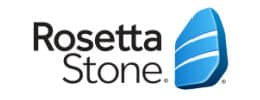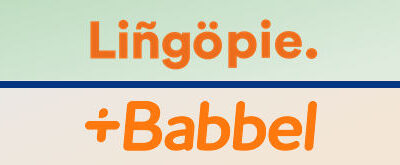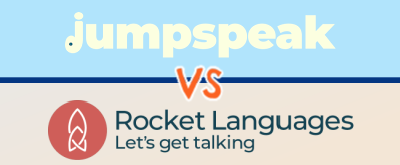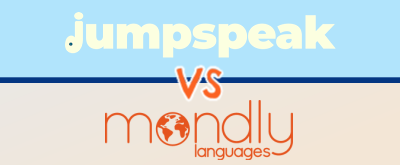Pimsleur and Rosetta Stone are two of the biggest names in the language learning industry. In this comparison, we highlight the pros and cons of each program, so you can figure out which one is the better match for your learning style.
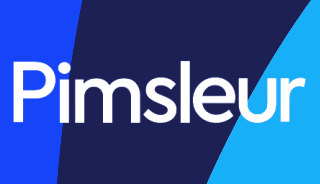
Free 7-Day Trial
Sign Up Today
|
$20/mo |
Pimsleur offers in-depth audio lessons, a modern interface, smart exercises, and rigorous content. It is the opposite of Rosetta Stone (audio vs visual). |
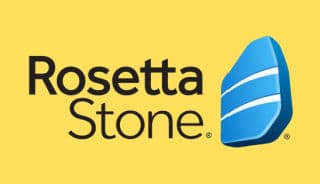
Discount: 60% OFF
Applied In Cart
|
$10-$15/mo |
The old school, tried and true language learning formula. With concepts of immersion and lots of images, it’s the perfect app for visual learners. |
Video: Pimsleur Or Rosetta Stone?
In the video above, Bianca from the Guide2Fluency team compares the language learning apps from Rosetta Stone and Pimsleur.
Editor’s Choice

Pimsleur
- 50+ Languages
- Money Back Guarantee
Pros
- Highly effective learning framework based on the Pimsleur Method
- Interactive audio lessons improve listening and verbal skills
- New Voice Coach feature provides pronunciation feedback
- Top-notch digital platform and mobile app
- Driving mode for learning while in the car
Cons
- Lessons are somewhat long
- Slightly more expensive than Rosetta Stone
How The Pimsleur & Rosetta Stone Programs Work
Before getting right into the strengths and weaknesses of each program, it would beneficial to understand how each app works from a high level. So let’s tackle a quick overview.
How Rosetta Stone Works
Each lesson in the Rosetta Stone program is fairly comprehensive. They’re all built around a core 30-minute learning module, with a mix of supplemental drills and exercises around that.
These supplemental drills cover language learning matters like pronunciation, grammar, reading, vocab, writing, and listening. They usually take around 5-10 minutes each, and move pretty fast after you finish the core module.
In total, I would say that a full lesson takes about an hour or so to complete on average.
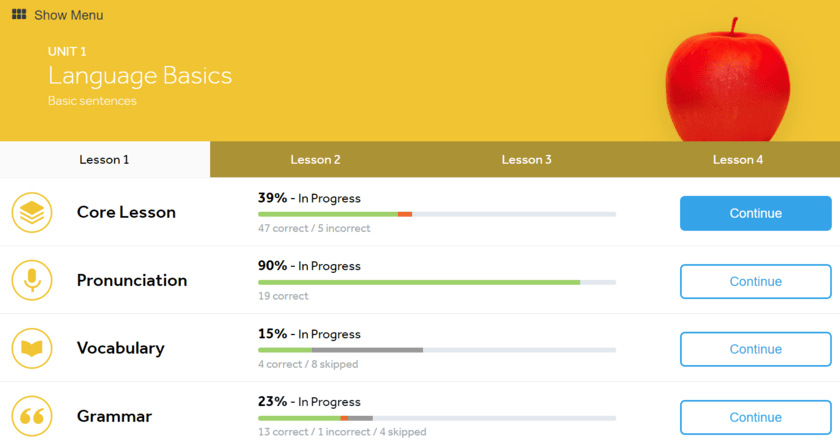
As for how the core lessons work, the thing to know about Rosetta Stone is that the program is largely built around images. Almost every single exercise in the course consists of a series of pictures in a grid, which you use in some way or another.
Sometimes the program will say something and you match what was said to the right picture. Sometimes the program will have you match written phrases to the images. Sometimes you must verbalize what you see in the image and have the speech software listen in. And sometimes the pictures are simply used to teach grammar.
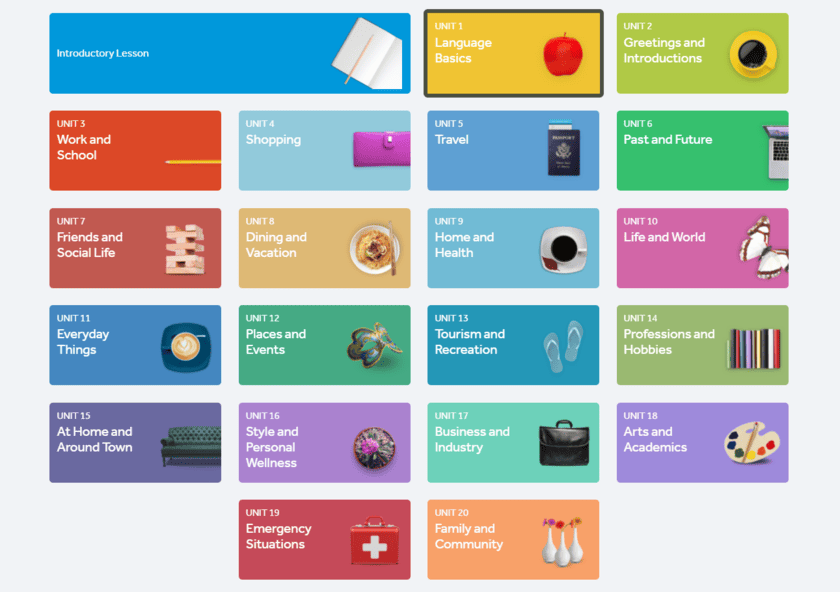
In short, no matter the format, Rosetta Stone mainly uses pictures to teach the language you’re learning.
The program is clearly designed to have you create mental associations between what you’re learning and imagery. This forces you to rely more on intuition rather than memorization to learn the language.
How Pimsleur Works
Pimsleur is a very different program from Rosetta Stone. Whereas Rosetta Stone is a very visual program, Pimsleur is based on audio lessons and conversational practice.
To start each Pimsleur lesson, you complete a 30-minute audio exercise where a moderator speaking in English walks you through a guided conversation step-by-step.
You’ll listen to a few sentences in your target language, the moderator will briefly stop to explain the situation to you, and then he’ll have you participate by answering questions and repeating phrases.
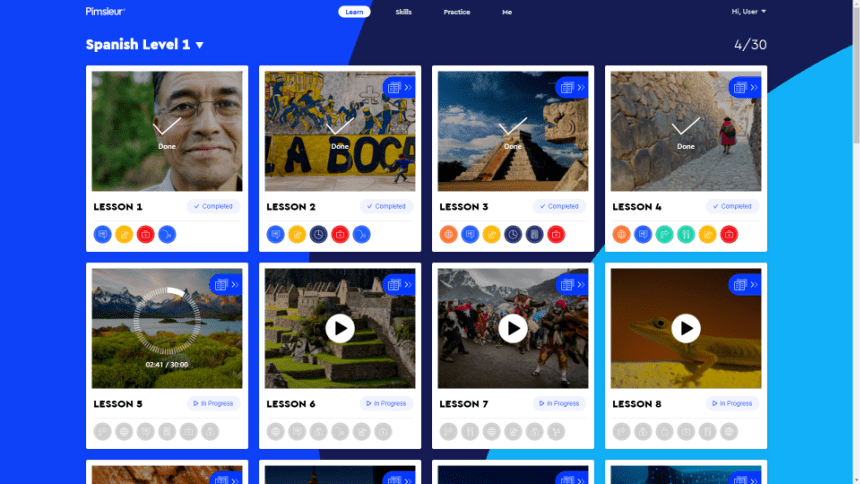
This 30-minute audio exercise is the backbone of each Pimsleur lesson, and frankly, it’s what Pimsleur is known for.
After you complete each audio lesson, you then review and reinforce what you just learned through a variety of drills and exercises. In a certain way, it’s kind of like class followed by homework.
These reinforcement drills include reading drills, digital flashcards, quizzes, pronunciation training, and speed games. Not to mention, Pimsleur does have some supplemental features too, such as vocabulary bonus packs and direct speaking exercises with Voice Coach (their new voice software).
That’s Pimsleur in a nutshell though. You’ve got core audio lessons, followed by detailed review exercises, with a few bonus tools wrapped around it.
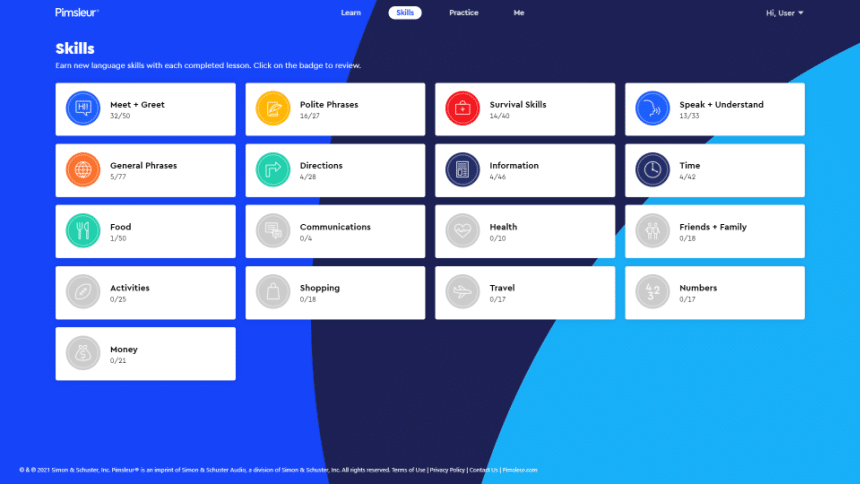
To quickly step back and recap, the key takeaway is that these two programs are very different in their approach. Both have comprehensive, near hour-long lessons, but the methodology is totally different.
Pimsleur uses audio lessons and conversational practice to teach, while Rosetta Stone relies almost exclusively on imagery and immersion.
Cost Comparison
Next, let’s quickly talk about pricing and cost. Rosetta Stone has three plans to choose from. There’s a 3-month subscription plan, which costs $12 per month. Then there’s a 12-month plan, which also costs $12 per month (often found for $8/month). And lastly, there’s a lifetime plan, which is a one-time purchase and gets you access for life to all of Rosetta Stone’s languages. That retails for $300 (sometimes found for $180).
Pimsleur, on the other hand, offers a couple different plans, both of which are monthly, pay-as-you-go subscription options. First, is the Pimsleur Premium Plan, which gets you access to one language. That plan costs $20 per month. Then there’s the Pimsleur All Access Plan, which gets you access to all 51 of Pimsleur’s languages. That plan costs just a buck more per month (i.e., $21 per month).
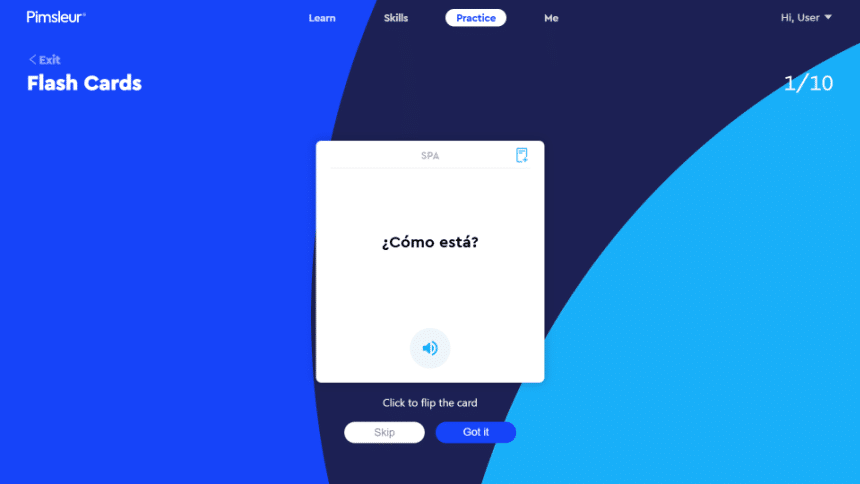
Putting that in perspective, Rosetta Stone is cheaper than Pimsleur by around $8 to $12 per month on average. Though I would just note that both Pimsleur and Rosetta are pretty good about running discounts, and you can usually lock in a lower rate, so make sure to check for coupon codes before buying.
Why Pimsleur Is Better Than Rosetta Stone
Next, let me break down the ways in which each app is superior to the other. Let’s begin with a discussion on Pimsleur’s strengths.
Lesson Focus On Speaking & Listening
The first win for Pimsleur over Rosetta Stone is their focus on listening comprehension and speaking practice.
One of the fastest ways of learning a language is getting frequent, heavy doses of verbalization.
You need to consistently hear and speak the language you’re learning to get comfortable with it and understand it. And Pimsleur just offers more of an opportunity to do that than Rosetta.
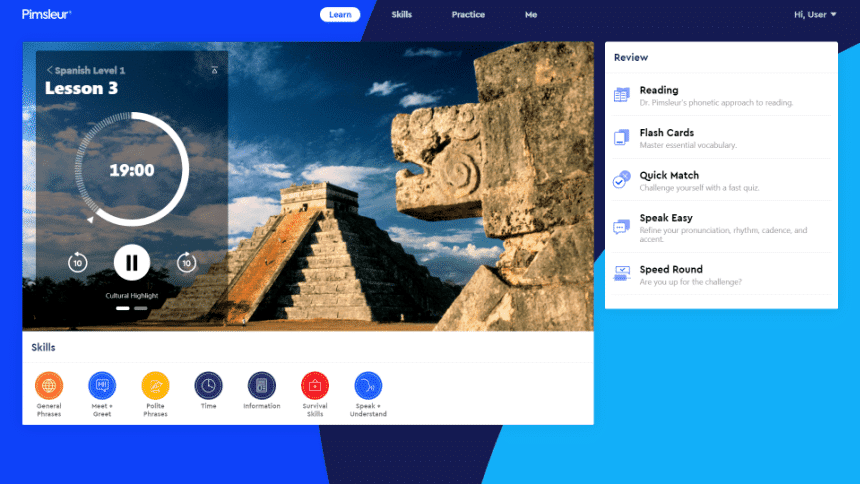
Rosetta Stone has some on demand videos and short exercises that require you to speak, but it’s not the same as what Pimsleur’s audio lessons offer.
The Pimsleur audio exercises are great at building your listening and speaking skills, and you’ll develop an ear for the language much more quickly by listening to their audio lessons every day.
Voice Coach Tool
Piggybacking on that last point, another superior aspect of the Pimsleur program is speech software.
As noted, Rosetta Stone has a handful of exercises in each lesson where you have to speak and have what you’re saying graded by their speech software (called TruAccent).
However, although Rosetta Stone’s software always gets a bunch of attention, I prefer Pimsleur’s new voice recognition software tool.
The Pimsleur program listens to you say words and phrases, and then gives you feedback on your pronunciation on a star system basis. Relatively speaking, the accuracy of the feedback is really strong and not over-sensitive.
That’s actually my biggest issue with Rosetta Stone’s TruAccent technology—it’s just so over-sensitive. There were times when I knew I would be saying a word correctly, but Rosetta Stone would make me repeat it over and over—sometimes 3 or 4 times in a row.
This became somewhat annoying, and I never seemed to have that problem with Pimsleur’s software. Plus, one feature that I especially like about Pimsleur’s tech is “challenge mode.”
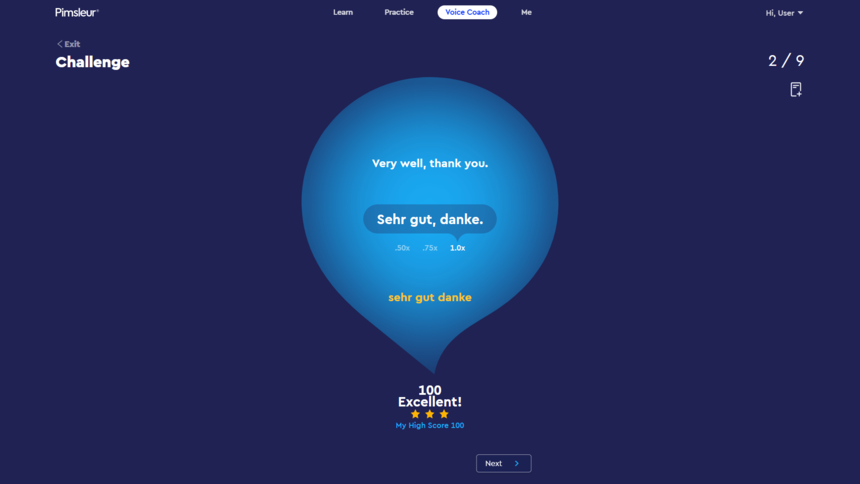
When you turn this feature on, you’ll be prompted in English to say a phrase in your target language with no hint as to how to say it. This makes you think critically about what to say, plus you still need to nail your pronunciation. It’s a difficult exercise, but very helpful.
Lesson Flexibility
The last advantage worth noting for Pimsleur is the flexibility in when and how you can work their lessons. Because the Pimsleur audio lessons are audio-based, they’re a lot more flexible than Rosetta’s picture-based lessons.
You don’t have to be staring at a screen, matching pictures to phrases all day. With the Pimsleur audio lessons, you can hit play and go about whatever you’re doing.
You can do a lesson while you’re taking a walk, cleaning the house, re-organizing your closet, etc. In essence, you can still be productive with your time while doing a lesson. It’s a big bonus.
In fact, you can even do an audio lesson while driving because they have a special driving mode, which is really nice.
👉 Read Our Full Pimsleur Spanish Review
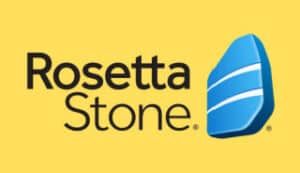
Rosetta Stone
- 20+ Languages
- Money Back Guarantee
Pros
- Learning framework built around immersion (makes you think critically)
- Emphasis on visuals and imagery (great for visual learners)
- Lots of nice supplemental learning tools, like on demand videos
- Very clean and easy to use interface
- Subscription plans are more affordable
Cons
- Lessons can become repetitive (all picture-based)
- Wish there was more in-depth verbal practice
Why Rosetta Stone Is Better Than Pimsleur
Knowing where Pimsleur has the edge over Rosetta Stone, let’s now shift gears and talk about Rosetta’s wins.
Imagery For Visual Learners
The first advantage for Rosetta Stone (and where I see them beating Pimsleur in a major way) is through all of the visuals and graphics in the program.
If you’re a visual learner, I think there’s no doubt about it, you have to go Rosetta Stone.
Some people are just pure visual learners. They mentally associate the new things they learn with pictures and graphics, so when they hear that word again, the image comes straight to mind.
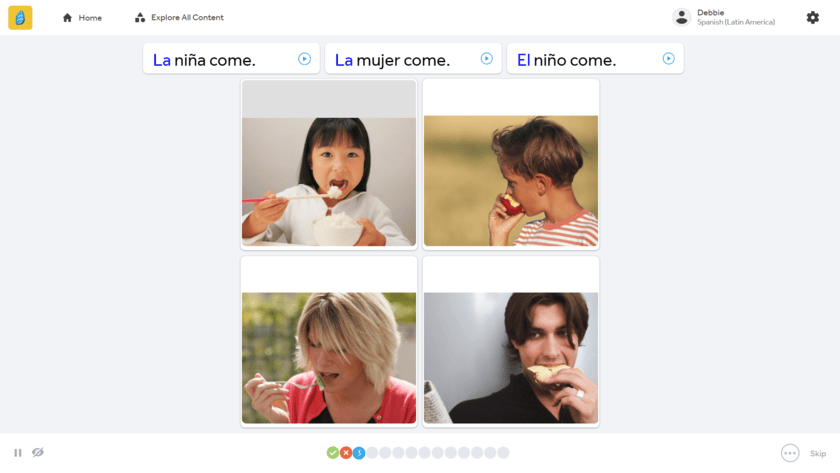
In this way, the learning process sort of cuts English out as a go-between. Instead of just memorizing vocabulary as it translates to English, you directly associate the word you’re learning with the raw, substantive meaning—not another English word.
Therefore, if you’re one of these people that learns visually and makes mental associations, Rosetta Stone is great. With all of the pictures in the program, it will be very effective for you.
Focus On Immersion
Another aspect of the Rosetta Stone framework that I like is its use of immersion. Basically, throughout the Rosetta Stone program there is hardly any use of English.
They don’t directly tell you what to do in each exercise in English, or translate words and sentences for you.
This all goes back to the point I noted above about learning intuitively. Rosetta Stone wants you to be immersed in the new language for the period of time that you’re sitting there working exercises. They want you to struggle a little bit—it’s part of the process.
Now, to be fair, they do in some parts of the program give you translations, but usually you have to dig for it and turn this feature on.
While this sounds hard, the reality is that the fastest, most effective way of learning a language is being immersed in the culture and hearing the language day in and day out, and Rosetta Stone tries to give you a brief stint of that everyday.
To some people, this can be a little frustrating and discouraging because you will get hung up and completely stuck at times, but if you don’t mind struggling at certain parts, it can be highly effective.
Extra Learning Tools
The final highlight for Rosetta Stone is all of the cool, extra resources they provide. When it comes to extra resources, Pimsleur just doesn’t provide much. There are no leaderboards, videos, podcasts, or games.
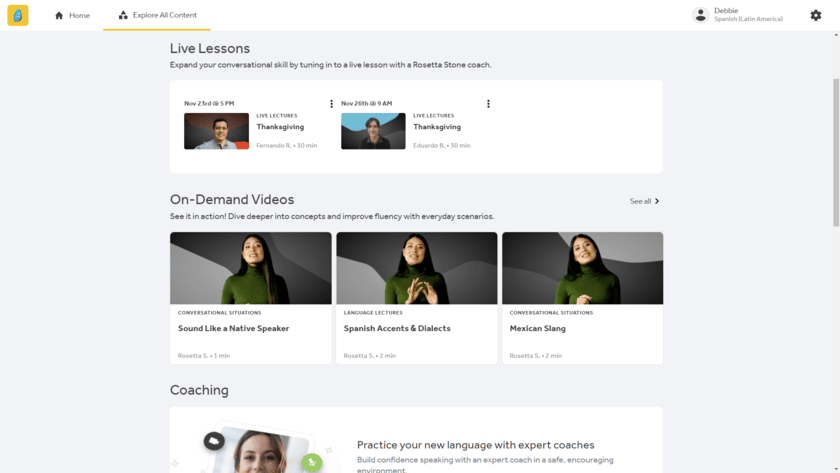
Yet Rosetta Stone goes the opposite direction. They offer more supplemental tools than just about every other language learning app.
There are phrasebooks, short on-demand video lessons, stories, audio companion lessons, and even some live lessons. Rosetta has an incredibly comprehensive suite of tools for you to use outside of the main lessons.
Thus, if you’re very serious about learning and want to do some extra credit outside of your daily lessons, Rosetta Stone will give you more opportunity than Pimsleur (and just about every other language learning company).
Verdict: Which Language App Is Better?
While I like both programs, for me personally, I prefer Pimsleur. Their program just jives better my style of learning.
The audio lessons are engaging and effective, and the way they are backstopped with reinforcement drills makes each lesson feel incredibly comprehensive. Plus, with their new Voice Coach speech software, Pimsleur just has all the bases covered.
However, that’s not to say that everyone would like Pimsleur better. If you’re more of a visual learner, Rosetta Stone could be a better fit for your learning style. Not to mention, they have some awesome extras that I really like.
At the end of the day, I personally found the Pimsleur lessons to be more engaging and a better fit for what I was looking for, but I don’t think you can go wrong with either program between these two.
Lesson format is the biggest difference between Pimsleur and Rosetta Stone. The Pimsleur lessons are centered around interactive audio lessons with fluent speakers, while the Rosetta Stone lessons revolve around imagery and language immersion. In other words, Rosetta Stone is very image heavy and Pimsleur is very audio heavy.
Which program is better somewhat depends on your style of learning. If you’re a visual learner, Rosetta Stone will likely be a better fit with its image-heavy lessons. However, if you’re more of an auditory learner, Pimsleur’s audio lessons are very hard to beat. We give Pimsleur a slightly better overall grade.
No, the typical Pimsleur subscription costs about $8 more per month than Rosetta Stone on average.

